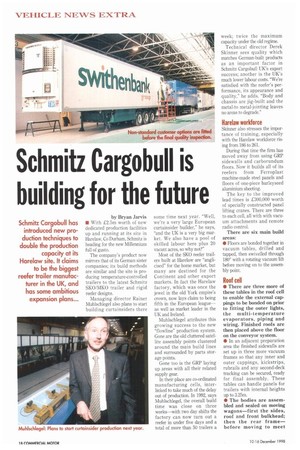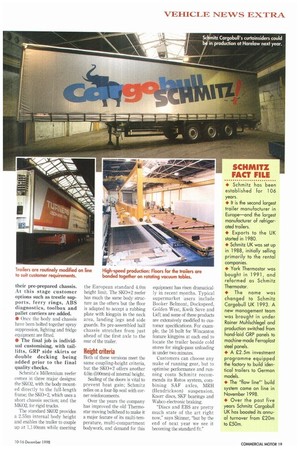Schmitz Cargobull is building for the future
Page 20

Page 21

If you've noticed an error in this article please click here to report it so we can fix it.
Schmitz Cargobull has introduced new production techniques to double the production capacity at its Harelaw site. It claims to be the biggest reefer trailer manufacturer in the UK, and has some ambitious expansion plans... by Bryan Jarvis • With £2.5m worth of new dedicated production facilities up and running at its site in Harelaw, Co Durham, Schmitz is heading for the new Millennium full of gusto.
The company's product now mirrors that of its German sister companies; its build methods are similar and the site is producing temperature-controlled trailers to the latest Schmitz SKO/MKO trailer and rigid reefer designs.
Managing director Rainer Muhlschlegel also plans to start building curtainsiders there some time next year. "Well, we're a very large European curtainsider builder," be says, "and the UK is a very big market. We also have a pool of skilled labour here plus 20 vacant acres, so why not?"
Most of the SKO reefer trailers built at Harelaw are "anglicised" for the home market, but many are destined for the Continent and other export markets. In fact the Harelaw factory, which was once the jewel in the old York empire's crown, now lays claim to being fifth in the European league— as well as market leader in the UK and Ireland.
Muhlschlegel attributes this growing success to the new Towline" production system. Gone are the old cluttered satellite assembly points clustered around the main build lines and surrounded by parts storage points.
Gone too is the GRP laying up areas with all their related supply gear.
In their place are co-ordinated manufacturing cells, interlinked to take much of the delay out of production. In 1992, says Muhlschlegel, the overall build time was close on three weeks—with two day shifts the factory can now turn out a reefer in under five days and a total of more than 50 trailers a week; twice the maximum capacity under the old regime.
Technical director Derek Skinner sees quality which matches German-built products as an important factor in Schmitz Cargobull UK's export success; another is the UK's much lower labour costs. "We're satisfied with the reefer's performance, its appearance and quality," he adds. "Body and chassis are jig-built and the metal-to metal-jointing leaves no areas to degrade."
Harelaw workforce
Skinner also stresses the importance of training, especially with the Harelaw workforce rising from 186 to 261.
During that time the firm has moved away from using GRP sidewalls and carborundum floors. Now it builds all of its reefers from Ferroplast machine-made steel panels and floors of one-piece barleyseed aluminium sheeting.
The key to the improved lead times is £300,000 worth of specially constructed panel lifting cranes. There are three to each cell, all with with vacuum attachments and remote radio control.
There are six main build areas: • Floors are bonded together in vacuum tables, drilled and tapped, then swivelled through 180° with a rotating vacuum lift before moving on to the assembly point.
Roof cell
• There are three more of these tables in the roof cell to enable the external cappings to be bonded on prior to fitting the outer lights, the multi-temperature evaporators, piping and wiring. Finished roofs are then placed above the floor on the conveyor system.
• In an adjacent preparation area the finished sidewalls are set up in three more vacuum frames so that any inner and outer cappings, kickstrips, rubrails and any second-deck tracking can be secured, ready for final assembly. These tables can handle panels for trailers with internal heights up to 3.25m.
• The bodies are assembled and sealed on moving wagons—first the sides, roof and front bulkhead: then the rear frame— before moving to meet
their pre-prepared chassis. At this stage customer options such as trestle supports, ferry rings, ABS diagnostics, toolbox and pallet carriers are added.
• Once the body and chassis have been bolted together spray suppression, lighting and fridge equipment are fitted.
• The final job is individual customising, with taillifts, GRP side skirts or double decking being added prior to the final quality checks.
Schmitz's Millennium reefer comes in three major designs: the SK02, with the body mounted directly to the full-length frame; the SK0+2, which uses a short chassis section; and the 141K02, for rigid trucks.
The standard SK02 provides a 2.55m internal body height and enables the trailer to couple up at 1,140mm while meeting the European standard 4.0m height limit. The SK0+2 reefer has much the same body structure as the others but the floor is adapted to accept a rubbing plate with kingpin in the neck area, landing legs and side guards. Its pre-assembled half chassis stretches from just ahead of the first axle to the rear of the trailer.
Height criteria
Both of these versions meet the same coupling-height criteria, but the SK0+2 offers another 4.0in (100min) of internal height.
Sealing of the doors is vital to prevent heat gain; Schmitz relies on a four-lip seal with corner reinforcements.
Over the years the company has improved the old Thermostar moving bulkhead to make it a major feature of its multi-ternperature, multi-compartment bodywork, and demand for this equipment has risen dramatically in recent months. Typical supermarket users include Booker Belmont, Dockspeed, Golden West, Kwik Save and Lidl; and some of these products are extensively modified to customer specifications. For example, the 16 built for Wincanton feature kingpins at each end to locate the trailer beside cold stores for single-pass unloading in under two minutes.
Customers can choose any make of running gear, but to optimise performance and running costs Schmitz recommends its Rotos system, combining SAF axles, MR11 (Hendrickson) suspension, Knorr discs, SKF bearings and Wabco electronic braking.
"Discs and EBS are pretty much state of the art right now," says Skinner, "but by the end of next year we see it becoming the standard fit."
SCHMITZ FACT FILE












































































































